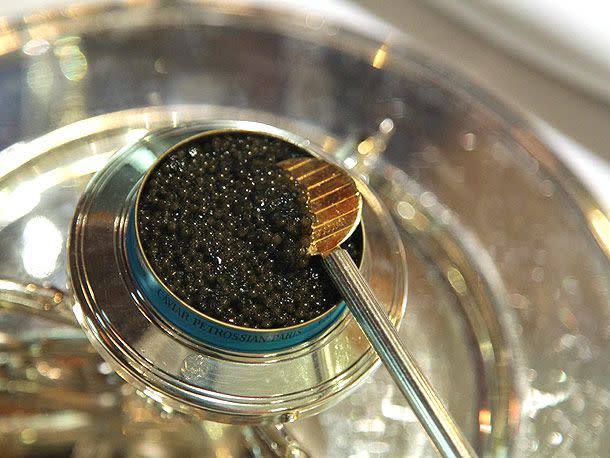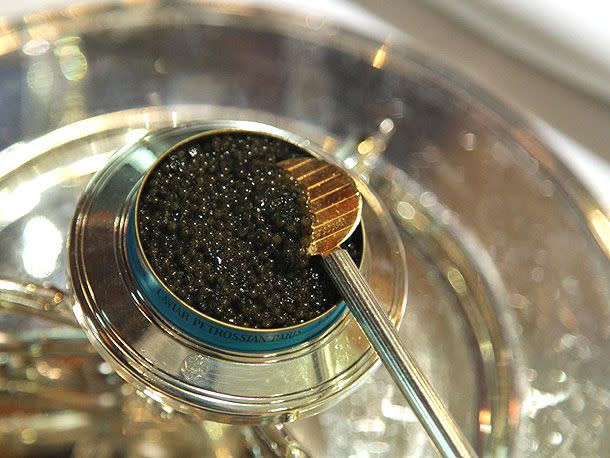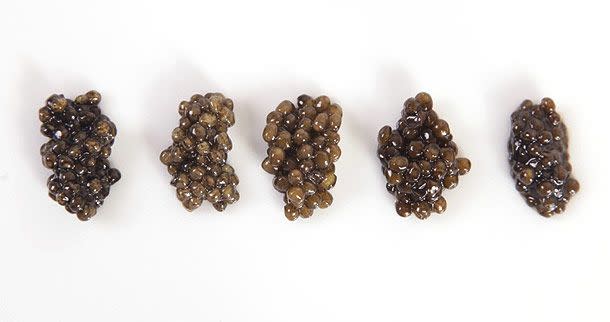Serious Eats Guide: How to Buy Caviar
How to buy, taste, and serve caviar with confidence.

Serious Eats / J. Kenji López-Alt
As a half-Japanese American, salty preserved fish products are in my blood. I grew up eating tarako, the salted, cured roe of Alaskan pollock, served inside rice onigiri, or grilled up for breakfast. But it wasn't until I started working at fancy-pants restaurants that I first tasted real caviar. The first bite I had was a small dollop of Iranian ossetra that I ate off of a plastic spoon the chef handed me in the walk-in refrigerator. Subtly salty with a distinct minerality and an aroma of the sea, the beads of sturgeon roe rolled across my tongue, popping against the roof of my mouth in little saline bursts. It was mind-blowing stuff, and I relished every opportunity to work with it and taste the many varieties available.
Caviar is technically the salted roe of sturgeon, a prehistoric, scale-less fish that ranges in the Northern hemisphere from North America to China. At the market, you'll also find cured eggs from other fish that are occasionally referred to as caviar, but their labeling will always indicate the type of fish they came from, such as "American spoonbill caviar" or "Salmon caviar." Depending on the species of sturgeon, area of harvest, and treatment of the eggs after harvest, caviar can vary in texture, flavor, and appearance.
What was once a wild-harvested product is now largely farm-raised. During the Soviet era, the harvest and production of wild caviar was a tightly controlled, highly lucrative industry in the Caspian and Black seas. But this all changed with the dissolution of the USSR—everybody wanted a piece of the pie. The ensuing over-fishing of sturgeon has been devastating to the ecosystem and the industry. The sale of Beluga caviar—the most highly prized of the three most famous sturgeon species—has been banned by the United States Fish and Wildlife Service since 2005. Wild ossetra sturgeon have likewise been harvested to near extinction. Their caviar is currently unavailable.
These days, most of the caviar available in the U.S. comes from farmed fish around the world—the United States, China, and Israel being some of the largest producers. So what does this new market look like, and more importantly, how can you buy it with confidence?

Serious Eats
We sat down with Alexandre Petrossian, 30, the third generation Vice President of Petrossian, to talk about the salty fish eggs. The famed Paris caviar house has an online boutique as well as a shop and restaurant in New York. "They say that a good caviar should have at least 15 different flavors in it," he starts. "Each time you take a bite, you should taste something new. It should develop on your tongue and the aftertaste should linger for a very long time."
"Surprisingly, the Chinese farms are some of the best," he says. Petrossian currently offers several varieties of Chinese caviar, including their Imperial Shassetra and Kaluga, which is amongst the more expensive in their line-up. "They actually came to us before they started designing the farms, asking for details about every step of the process, and how we like our caviar to be raised and harvested. They were really determined to do it right." Because of this, the Chinese caviar is among the most consistent.
I brought back five tins of sturgeon caviar to Serious Eats World Headquarters where we had a blind tasting. The caviars ranged in price from $113 to $481 per 50 gram tin. But our favorites were not the most expensive.
"Good caviar should have distinct eggs that separate when you roll them on the roof of your mouth," says Alexandre. "They need to pop," rather than taste mushy. When you open a tin, the caviar should be shiny, each egg glistening, not oily or murky. "Good caviar sparkles like diamonds," says Alexandre. "It makes it quite difficult to take photographs."
How To Taste And Serve Caviar

Serious Eats / J. Kenji López-Alt
The traditional accompaniments to caviar are Champagne or ice cold vodka. "Avoid a heavier red or white wine with caviar," advises Alexander. "It will compete with the flavor." If tasting a variety of different caviars, drink water or sparkling water between varieties to cleanse your palate.
I prefer to taste caviar straight out of the tin using a spoon. Mother-of-pearl is pretty and the traditional choice, but you don't need a fancy spoon to eat it. "I taste my caviar from a wooden spoon, because that's how I was taught to taste it growing up," says Alex. I like to use plastic spoons. The only material to avoid is silver, which can react with the caviar to give it a metallic flavor.
If you want to put a little more work into the presentation, toast, cold boiled potatoes, or blini are all excellent, relatively bland backdrops that will give you some body, but not compete with the caviar for flavor. Sour cream and chives also work well.
When the caviar is in your mouth, let the individual eggs spread on your tongue first, gently rolling them against the roof of your mouth while you breathe in through your nose to get the initial aroma. Once you've got it, crush the eggs gently, feeling them pop against your soft palate, releasing their buttery contents. This is where the primary flavor of the caviar should come out. Try and identify as many flavors as you can. Buttery, rich, nutty, earthy, salty, fishy are all common descriptors for caviar.
Finally, swallow the caviar, continuing to breathe in through your nose to allow its aftertaste to linger as long as possible. Take a shot, clear your head, lather, rinse, and repeat.
How To Buy Caviar

Serious Eats
Shopping for caviar can be intimidating. Here are five tips to make sure that you get your money's worth.
#1: More Expensive ≠ Better
Ok, let's face it: even the most inexpensive sturgeon caviar is still going to be expensive. You should expect to spend at least $50 to $75 for 30 grams (1 ounce)—enough caviar to make a few good bites for two people. But the prices can get astronomically high. The Special Reserve Ossetra from Petrossian runs at $5,000 a kilo, or $165 for a 30-gram tin.
Does paying more guarantee better caviar?
"No, not at all," says Alexandre. "The main factor that determines the price of the caviar is its rarity, but that does not mean that the rarer caviar tastes better to all people."
Caviar is generally graded by the size and texture of its beads (larger, firmer beads that pop in your mouth are rarer, and thus more expensive), and by their flavor—as a general rule, more mildly flavored caviars tend to be rarer. However, the species of the fish, how it was raised, and how the caviar was treated and matured can vastly affect the final flavor.
Just as with wine or whiskey, many tasters—even professionals—prefer the flavor and texture of less expensive, more common offerings, so long as they are tasted blind without knowledge of pricing.
In a completely blind taste test at our office, many tasters picked out Petrossian's Royal Transmontanus ($69/30 grams) as their favorite, beating out caviars over four times the price.
#2: Start at the low end
Caviar can be an acquired taste, and like many expensive foods prized for the complexity, there is a learning curve when it comes to appreciating their subtlety. Dive right into the deep end with the more expensive caviars, and most likely those more delicate flavors will be missed by you, and your money will have been wasted.
A better approach is to start with a relatively inexpensive—but still high quality—caviar. Taste it carefully and thoughtfully, figure out what it is you like about it. Do you like buttery richness and nutty flavor? Or perhaps a more pronounced fishiness and saltiness? Once you can answer these questions, you'll be better equipped to talk to the salesperson and help them pinpoint a caviar that is custom-suited to your personal preferences.
#3: If they don't let you taste it, shop somewhere else
When shopping for caviar, make sure that you taste the product before you buy it. You wouldn't buy a $125 pair of shoes without trying it on; why would you drop that kind of cash on caviar if you aren't sure you're going to like what you get?
Caviars can vary from batch to batch or tin to tin, even when they're coming from the same farm or same species of fish. For this reason, past experience is not a reliable indicator of future performance. Indeed, Alexandre suggests you take it one step further: insist on tasting a sample of caviar from the actual tin you are planning on buying. An unscrupulous caviar salesman is not above the old bait-and-switch, swapping out a tin of dry or sub-par caviar.
#4: Make sure you buy enough
Whether it's knowing the value of what they're about to taste or fear of the unknown, first-time caviar tasters often go in for a tiny nibble, placing a half dozen eggs on their tongue. "It is impossible to taste caviar in this way," says Alexandre. "You must have enough to roll on your tongue to understand the texture and aroma." 5 grams (a heaping half teaspoon) is a more reasonable size for a taste.
For this reason, a 30-gram tin (about 1 ounce) should be the absolute minimum you purchase when shopping for two people. Those cute little 10-gram tins may be tempting—and their relatively low price makes them even more so—but unless you plan on tasting by yourself and having only a couple bites, they are essentially useless.
#5: Be careful when you buy online or black market caviar
Given rule #3, this one goes without saying. There is no guarantee of quality for any caviar you cannot taste yourself, so buying from an online source is an almost guaranteed way to get sub-par product. If you must buy online, shop at a reputable source who is committed to keeping that good reputation. Russ & Daughters, and Petrossian are good places to start.
"With caviar, if the price seems too good to be true, then it is," says Alexandre. Similarly, black market caviar has no guarantee, no culpability for sub-par product, and even worse for some, no accountability for the environmental damages caused by illegal poaching of severely depleted wild sturgeon stocks.
#6: Only buy as much as you need and eat it fast
Like a good cheese or high quality cured ham, good caviar is cured and matured by experts for a specific amount of time to maximize their flavor. Once it is sold and the tin is opened, it can very rapidly change in quality, developing fishier aromas, the eggs softening, turning stickier or oilier, liquid weeping out into the tin. Once you've bought the caviar keep it refrigerated until you open the tin, which should be done within a few days of purchase. Once opened, the caviar should be consumed within a day.
February 2013
Read More
Read the original article on Serious Eats.
